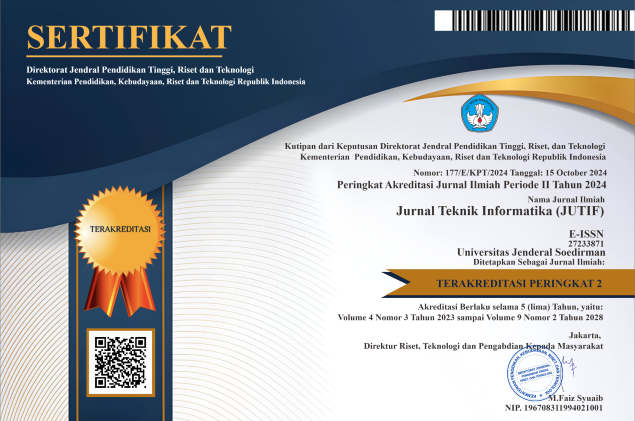Prediction of Turbidity Removal Time in Electrocoagulation Wastewater Using Random Forest, XGBoost, and Others: A Data-Driven Information System Approach
DOI:
https://doi.org/10.52436/1.jutif.2025.6.4.4847Keywords:
Electrocoagulation Turbidity Removal, Random Forest, Wastewater Treatment, Water Resource AssetAbstract
Electrocoagulation is an effective and environmentally friendly technology for treating wastewater by removing contaminants such as turbidity, heavy metals, and organic compounds. Accurately predicting turbidity removal time is essential for optimizing treatment performance and operational efficiency. However, this is challenging due to complex, nonlinear relationships between multiple parameters including current, voltage, electrode configuration, conductivity, and turbidity removal rate. This study aims to develop a predictive framework by comparing six supervised regression models, namely Linear Regression, Polynomial Regression, Random Forest, Support Vector Regression (SVR), XGBoost, and Long Short-Term Memory (LSTM), using key electrocoagulation parameters. After extensive data preprocessing, a dataset of 281 samples was used for training and validation. Among them, Random Forest achieved the best performance (R² = 0.876, RMSE = 601.15). A data-driven information system is proposed to integrate these predictive capabilities for real-time monitoring and control. By improving turbidity prediction accuracy, the system enables the sustainable utilization of water as a valuable asset, even in its wastewater form. The approach enhances decision-making by providing intelligent feedback for process optimization. This research contributes to the advancement of intelligent, sustainable wastewater treatment systems by integrating machine learning prediction models with practical process control applications in informatics.
Downloads
References
S. Suakanto, A. Setiawan, and W. A. Nurtrisha, “Data Modeling for Productive Asset and Supporting Asset,” in 2023 International Conference on Electrical Engineering and Informatics (ICEEI), 2023, pp. 1–6. doi: 10.1109/ICEEI59426.2023.10346719.
Y. G. Asfaha, A. K. Tekile, and F. Zewge, “Hybrid process of electrocoagulation and electrooxidation system for wastewater treatment: A review,” Clean Eng Technol, vol. 4, p. 100261, 2021, doi: https://doi.org/10.1016/j.clet.2021.100261.
F. Y. AlJaberi et al., “Can electrocoagulation technology be integrated with wastewater treatment systems to improve treatment efficiency?,” Environ Res, vol. 214, p. 113890, 2022, doi: https://doi.org/10.1016/j.envres.2022.113890.
A. Shahedi, A. K. Darban, F. Taghipour, and A. Jamshidi-Zanjani, “A review on industrial wastewater treatment via electrocoagulation processes,” Curr Opin Electrochem, vol. 22, pp. 154–169, 2020, doi: https://doi.org/10.1016/j.coelec.2020.05.009.
S. Davuluri, A. S. T S, N. P.V., and M. S. Kumar, “Industrial wastewater treatment by electrocoagulation process,” Sep Sci Technol, vol. 55, pp. 1–33, 2019, doi: 10.1080/01496395.2019.1671866.
H. I. Eldos, M. Khan, N. Zouari, S. Saeed, and M. A. Al-Ghouti, “Characterization and assessment of process water from oil and gas production: A case study of process wastewater in Qatar,” Case Studies in Chemical and Environmental Engineering, vol. 6, p. 100210, 2022, doi: https://doi.org/10.1016/j.cscee.2022.100210.
P. N. Alam, Yulianis, H. L. Pasya, R. Aditya, I. N. Aslam, and K. Pontas, “Acid mine wastewater treatment using electrocoagulation method,” Mater Today Proc, vol. 63, pp. S434–S437, 2022, doi: https://doi.org/10.1016/j.matpr.2022.04.089.
P. V. Ngobeni, M. Basitere, and A. Thole, “Treatment of poultry slaughterhouse wastewater using electrocoagulation: a review,” Water Pract Technol, vol. 17, no. 1, pp. 38–59, Nov. 2021, doi: 10.2166/wpt.2021.108.
J. Akansha, P. V Nidheesh, A. Gopinath, K. V Anupama, and M. Suresh Kumar, “Treatment of dairy industry wastewater by combined aerated electrocoagulation and phytoremediation process,” Chemosphere, vol. 253, p. 126652, 2020, doi: https://doi.org/10.1016/j.chemosphere.2020.126652.
L. Bilińska, K. Blus, M. Gmurek, and S. Ledakowicz, “Coupling of electrocoagulation and ozone treatment for textile wastewater reuse,” Chemical Engineering Journal, vol. 358, pp. 992–1001, 2019, doi: https://doi.org/10.1016/j.cej.2018.10.093.
W. Zhang, M. Zhang, J. Yao, and J. Long, “Industrial indigo dyeing wastewater purification: Effective COD removal with peroxi-AC electrocoagulation system,” Arabian Journal of Chemistry, vol. 16, no. 4, p. 104607, 2023, doi: https://doi.org/10.1016/j.arabjc.2023.104607.
N. M. Genawi, M. H. Ibrahim, M. H. El-Naas, and A. E. Alshaik, “Chromium Removal from Tannery Wastewater by Electrocoagulation: Optimization and Sludge Characterization,” Water (Basel), vol. 12, no. 5, 2020, doi: 10.3390/w12051374.
F. E. Titchou, H. Zazou, H. Afanga, J. El Gaayda, R. A. Akbour, and M. Hamdani, “Removal of Persistent Organic Pollutants (POPs) from water and wastewater by adsorption and electrocoagulation process,” Groundw Sustain Dev, vol. 13, p. 100575, 2021, doi: https://doi.org/10.1016/j.gsd.2021.100575.
A. Tahreen, M. S. Jami, and F. Ali, “Role of electrocoagulation in wastewater treatment: A developmental review,” Journal of Water Process Engineering, vol. 37, p. 101440, 2020, doi: https://doi.org/10.1016/j.jwpe.2020.101440.
S. Boinpally, A. Kolla, J. Kainthola, R. Kodali, and J. Vemuri, “A state-of-the-art review of the electrocoagulation technology for wastewater treatment,” Water Cycle, vol. 4, pp. 26–36, 2023, doi: https://doi.org/10.1016/j.watcyc.2023.01.001.
C. An, G. Huang, Y. Yao, and S. Zhao, “Emerging usage of electrocoagulation technology for oil removal from wastewater: A review,” Science of The Total Environment, vol. 579, pp. 537–556, 2017, doi: https://doi.org/10.1016/j.scitotenv.2016.11.062.
A. M. H. Elnenay, E. Nassef, G. F. Malash, and M. H. A. Magid, “Treatment of drilling fluids wastewater by electrocoagulation,” Egyptian Journal of Petroleum, vol. 26, no. 1, pp. 203–208, 2017, doi: https://doi.org/10.1016/j.ejpe.2016.03.005.
A. Shokri and M. S. Fard, “A critical review in electrocoagulation technology applied for oil removal in industrial wastewater,” Chemosphere, vol. 288, p. 132355, 2022, doi: https://doi.org/10.1016/j.chemosphere.2021.132355.
K. E. ADOU, A. R. KOUAKOU, A. D. EHOUMAN, R. D. TYAGI, P. DROGUI, and K. ADOUBY, “Coupling anaerobic digestion process and electrocoagulation using iron and aluminium electrodes for slaughterhouse wastewater treatment,” Sci Afr, vol. 16, p. e01238, 2022, doi: https://doi.org/10.1016/j.sciaf.2022.e01238.
N. S. Graça and A. E. Rodrigues, “The Combined Implementation of Electrocoagulation and Adsorption Processes for the Treatment of Wastewaters,” Clean Technologies, vol. 4, no. 4, pp. 1020–1053, 2022, doi: 10.3390/cleantechnol4040063.
I. Kabdaşlı, I. Arslan-Alaton, T. Ölmez-Hancı, and O. Tünay, “Electrocoagulation applications for industrial wastewaters: a critical review,” Environmental Technology Reviews, vol. 1, no. 1, pp. 2–45, 2012, doi: 10.1080/21622515.2012.715390.
S. Boinpally, A. Kolla, J. Kainthola, R. Kodali, and J. Vemuri, “A state-of-the-art review of the electrocoagulation technology for wastewater treatment,” 2023. doi: 10.1016/j.watcyc.2023.01.001.
W. Zhang, M. Zhang, J. Yao, and J. Long, “Industrial indigo dyeing wastewater purification: Effective COD removal with peroxi-AC electrocoagulation system,” Arabian Journal of Chemistry, vol. 16, no. 4, 2023, doi: 10.1016/j.arabjc.2023.104607.
F. Y. AlJaberi et al., “Can electrocoagulation technology be integrated with wastewater treatment systems to improve treatment efficiency?,” Environ Res, vol. 214, 2022, doi: 10.1016/j.envres.2022.113890.
P. P. Das, M. Sharma, and M. K. Purkait, “Recent progress on electrocoagulation process for wastewater treatment: A review,” Sep Purif Technol, vol. 292, p. 121058, 2022, doi: https://doi.org/10.1016/j.seppur.2022.121058.
Y. Mao, Y. Zhao, and S. Cotterill, “Examining Current and Future Applications of Electrocoagulation in Wastewater Treatment,” Water (Basel), vol. 15, no. 8, 2023, doi: 10.3390/w15081455.
M. Ebba, P. Asaithambi, and E. Alemayehu, “Investigation on operating parameters and cost using an electrocoagulation process for wastewater treatment,” Appl Water Sci, vol. 11, no. 11, p. 175, 2021, doi: 10.1007/s13201-021-01517-y.
M. Shen et al., “Efficient removal of microplastics from wastewater by an electrocoagulation process,” Chemical Engineering Journal, vol. 428, p. 131161, 2022, doi: https://doi.org/10.1016/j.cej.2021.131161.
A. El Jery, H. M. Salman, N. Al-Ansari, S. S. Sammen, M. A. J. Maktoof, and H. A Z Al-Bonsrulah, “Optimization of oil industry wastewater treatment system and proposing empirical correlations for chemical oxygen demand removal using electrocoagulation and predicting the system’s performance by artificial neural network.,” PeerJ, vol. 11, p. e15852, 2023, doi: 10.7717/peerj.15852.
N. A. Khan, S. Singh, P. C. Ramamurthy, and I. H. Aljundi, “Exploring nutrient removal mechanisms in column-type SBR with simultaneous nitrification and denitrification,” J Environ Manage, vol. 349, p. 119485, 2024, doi: https://doi.org/10.1016/j.jenvman.2023.119485.
Zakoor, Yousif, Gzar, Hatem, and Zakur, Yahya, “Municipal wastewater treatment and recycle by an electrocoagulation process and a submerged membrane bioreactor system,” E3S Web Conf., vol. 448, p. 3038, 2023, doi: 10.1051/e3sconf/202344803038.
Additional Files
Published
How to Cite
Issue
Section
License
Copyright (c) 2025 Sinung Suakanto, Tan Lian See, Zatul Alwani Shaffiei, Taufiq Maulana Firdaus, Muharman Lubis, Anggera Bayuwindra

This work is licensed under a Creative Commons Attribution 4.0 International License.



























